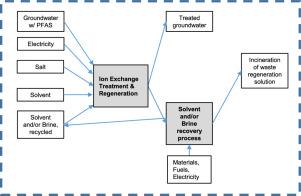Water Research ( IF 11.4 ) Pub Date : 2021-10-25 , DOI: 10.1016/j.watres.2021.117798 Treavor H Boyer 1 , Anderson Ellis 2 , Yida Fang 3 , Charles E Schaefer 3 , Christopher P Higgins 2 , Timothy J Strathmann 2

|
Although anion exchange resin (AER) treatment is considered an effective technology for removing per- and polyfluoroalkyl substances (PFASs) from impacted water, the environmental impacts associated with AER regeneration have not been systematically explored. In particular, the trade-offs of altering the composition of the regeneration solution and disposing of or recycling the waste regeneration solution are not known. To fill these important gaps in the literature, this research conducted a comparative life cycle assessment (LCA) of an AER-based PFAS remediation system with different regeneration scenarios including disposing of waste regeneration solution via incineration, reusing the organic cosolvent and brine fractions of the waste regeneration solution, and altering the composition of the regeneration solution to avoid organic cosolvent or NaCl. The results show that disposing of waste regeneration solution via incineration, without recycling organic cosolvent or brine, had the greatest environmental impact, and that incineration accounted for the greatest impact among contributing processes. Recycling of the cosolvent (or cosolvent and brine) fraction of the waste regeneration solution resulted in lower environmental impacts due to reduced mass of waste disposed of via incineration. Replacing NaCl in the brine with an alternative salt resulted in higher environmental impacts, with salts derived from chemical production, such as ammonium chloride and potassium carbonate, showing the largest increases in impacts. The results of this research highlight the importance of understanding the fate of PFASs during incineration, and the need for PFAS destruction technologies that can be coupled to AER regeneration to avoid incineration.
中文翻译:

PFAS 影响水的阴离子交换树脂修复再生方案的生命周期环境影响
尽管阴离子交换树脂 (AER) 处理被认为是从受影响的水中去除全氟和多氟烷基物质 (PFAS) 的有效技术,但尚未系统地探索与 AER 再生相关的环境影响。尤其是,改变再生溶液的组成和废弃再生溶液的处理或再循环的权衡是未知的。为了填补文献中的这些重要空白,本研究对基于 AER 的 PFAS 修复系统进行了比较生命周期评估 (LCA),该系统具有不同的再生方案,包括通过焚烧处理废再生溶液、再利用有机助溶剂和盐水馏分。废物再生解决方案,并改变再生溶液的组成以避免有机助溶剂或氯化钠。结果表明,通过焚烧处理废再生液,不回收有机助溶剂或盐水,对环境的影响最大,在贡献过程中,焚烧对环境的影响最大。由于通过焚烧处理的废物质量减少,废物再生溶液的助溶剂(或助溶剂和盐水)部分的回收导致较低的环境影响。用替代盐代替盐水中的 NaCl 会导致更大的环境影响,来自化学生产的盐,如氯化铵和碳酸钾,影响的增加幅度最大。









































 京公网安备 11010802027423号
京公网安备 11010802027423号